Today for you, my lovely readers, I have repeated my Repetitive Strain Injury blogs from two years ago, with an additional video to talk you through the tl;dr aspects of the post. This is helpful for everybody, not just knitters, and I’d love to help you if I can. Any feedback welcome!
Original Post – Follow Up Post
Repeated: Repetitive Strain Injury Posts
If you tell someone your hands hurt because you’ve been knitting too much, they usually have one or both of two reactions:
- How much do you have to knit to get an RSI?!
- Stop knitting. Immediately.
OK so we know I’m crazy and knit a lot; Reaction Number 1 doesn’t bother me. Reaction Number 2 should be enough to tell you how serious RSI can be if those who have previously experienced it can have such an extreme reaction.
Repetitive Strain Injury?
The clue is in the name – repetitive movements strain the structures in your hands and wrists, and you get an injury as damage due to constant identical movement occurs. Sounds fairly harmless, right? Wrong. If ignored, you can damage yourself so badly that it is irreversible. In other words – you would never be able to knit again.
One of the problems with this definition is that it is rather broad – there are a range of symptoms, including specific syndromes such as carpal tunnel that can fall under the bracket of an RSI. I’m not going to go into that, but if you are interested, let me know and I can give you a bit more of the information that I have collected.
How do I know if I have an RSI?
In knitters, focus areas tend to be the wrist or fingers as that is where the majority of the action happens. My research on Ravelry has also indicated that a lot of us ‘hang’ our heads off our necks as we knit, putting a lot of strain on our necks, shoulders and upper backs, and causing injuries there. We are also not helped by the fact that many of us spend a lot of time on computers, gripping our mouse and tapping away at our favourite thread on Ravelry (OK, probably working), with poor posture at the computer.
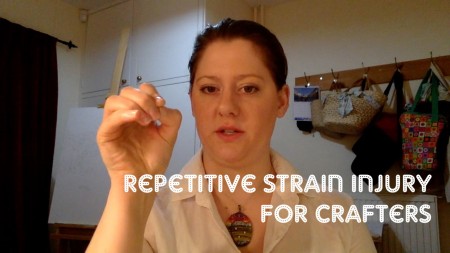
Typing and clicking are also repetitive movements, and hey, while the majority of the population doesn’t go straight on to another intensive repetitive activity after work, we do. For example, I get up in the morning, knit for an hour on my commute, walk for ten minutes, sit on my computer at work for eight hours, with about three or four short breaks, walk for ten minutes back to the tube station, knit for another hour. That’s ten straight hours, not including the couple of hours I may do in the evening. I know a lot of us do this – we have to consider ourselves a high-risk category in this case, so please do watch out for it.
Repetitive Strain Injury Symptoms
Common symptoms of an RSI include:
- Pain, localised to the area affected – this can be sharp or dull. I have it on the left side of my left wrist and palm, which just ache dully, and in the middle joint of my index, middle and little fingers of that hand, where I get stabbing pains.
- Swelling, stiffness or weakness – I find my rings don’t like coming off and have actually had to stop wearing them recently.
- Tingling or numbness – ever gripped your needles too hard and found you can’t feel the tips of your fingers, then pins & needles as sensation came back? That’s it.
- Sensitivity to temperature changes
- Throbbing or cramp
There are a number of other symptoms that are listed out there, but I’ve tried to condense it into the most common, which cover most bases.
In the beginning stages of the injury, you may notice one or more of these symptoms occasionally, for a few minutes at a time. For example, if you notice as you pop your knitting down to put the kettle on and pick up a choccie biscuit, that your hands feel like they are stuck in the position they were in as you knitted and are reluctant to move. Alternatively, your rings, which always came off quite happily before, suddenly start to be too small for you for a day, then go back to normal.
As you continue your activity – whether it’s in one session where you notice a dull ache and ignore it, or over some days/weeks where you notice symptoms on a regular basis, the effects will fade more slowly, and less each time. You will notice symptoms for some time after you have stopped the activity.
Eventually, you could be stuck with constant symptoms which will simply not go away – at which point the injury is permanent and there is very little that can be done about it without some pretty sturdy medical intervention.
Treatment
The most effective treatment in the early stages is rest. You can take an anti-inflammatory to reduce pain, such as ibuprofen or aspirin. Simple stretches will also help.
If you think you could have an RSI, I reckon you should go see the doctor if you’ve never done so before. You don’t know what you’re dealing with, and the GPs can use their experience to let you know if it is definitely an RSI, or if it is anything worse. A diagnosis is typically made on the basis that the injury occurred following a repetitive injury.
If you do not want to go see a GP but you have pain for more than three weeks, you should definitely go see a doctor. You do not want things to get worse!
Medical interventions can range from simply splinting the area of interest to prevent excess movement and giving your muscles and tendons a break, to physical therapies such as stretching and exercises; steroid injections to anti-inflammatory drugs. The more serious treatments are to be avoided! It’s better to catch early than to have to progress to procedures which can take 3 to 6 months to heal, if at all.
In the case of knitters, hearsay and Ravelry shows that having a break of at least a day where you do not knit at all, in the slightest, not even a single stitch, can help prevent things getting more serious; as soon as you notice any symptoms.
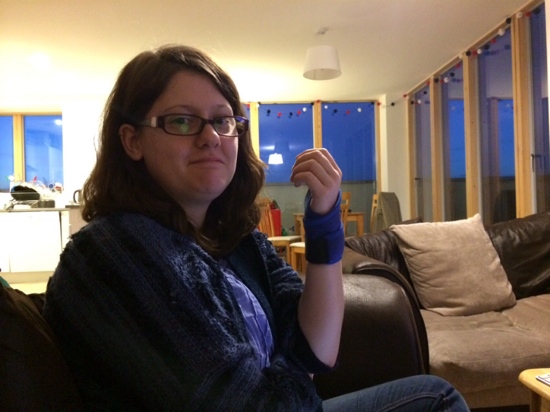
Advice from fellow knitters
The advice I have compiled here has come about from browsing a huge number of RSI topics on Ravelry, writing all the little tips I could find that people have found helped, and collating them into the most commonly used remedies. Please, do not think that this is medical advice, because it’s not – it’s simply a collective of experience, and combines treatment and prevention issues.
Needles
Bamboo needles are said to help, with arthritis sufferers often saying this helps them too. Maybe it’s because they’re lighter, or maybe they slide out of your hands less easily so you don’t have to hold onto them as hard? Another common theory is that they retain the heat of your hand and this can be easier to cope with.
Square shaped needles can also be noticeably less painful, as told by Ravellers who have switched from cylindrical needles to square. The only thing I can attribute this to is that you don’t have to grip the needles as hard to stop them rolling! I’m definitely going to try a set.
Circular needles are by far the most mentioned needle-type to help with pain. The weight of the project rests on the lap rather than hanging off the needles on the wrists, which lets you relax a bit more.
Yarn
Different types of yarn make a difference to RSI. This is something I have noticed in the past, noticeably when I was knitting Digger in a cotton yarn. Elastic yarns have been found to strain knitters less – I don’t mean you have to knit with actual elastic, but wool and other fibres with more give can be less hard on the hands.
Many knitters have also found that using a finer gauge means less pain. Your guess is as good as mine as to why this one works!
Knitting Style
Do you knit continental or English? This is an extremely common factor – my search seemed to say that continental was better, but by far the most positive reaction was if you switch between continental and English between projects. This may be because the type of repetitive motion is reduced, so the strain is largely reduced as well.
Monogamous knitters may also be at a disadvantage – having a variety of projects on different needle sizes means that if you start getting tired on one set, you can switch to a different one and vary the way you are using your muscles depending on your needles. I found this fascinating – but a lot of people definitely think it works, and I do have a blanket stashed somewhere on 15 mm’s that I may dig out….
Finally, reducing the amount of moment of your hands can help – I have certainly noticed this as I hold the needles a lot closer to the tips than I used to and the pain has been better.
Tension
Many knitters – especially new knitters or those concentrating on difficult sections of a piece – get extremely tense. This is often seen in fingers, wrists, shoulders and the neck. How do you deal with this?
Our Ravellers find that periodically putting the knitting down, standing up and straightening arms above the head, then giving a good ole shake and roll of the shoulders will help.
To reduce tensions, try to avoid knitting to a deadline, or if you do have a deadline to knit to, approach a session of knitting calmly. Yoga before or after may help! We’ve all done it, and if you must, then taking a break where you knit less intensively for a few days will help your body recover.
Non-knitting activities
An activity that a number of Ravellers has cited as helping is probably one of the easiest you could think of. Just sleep in a wrist brace. I intend to do this myself – scientifically, it is thought to help because you heal while you rest, and the brace keeps your joint still to help prevent excessive movement.
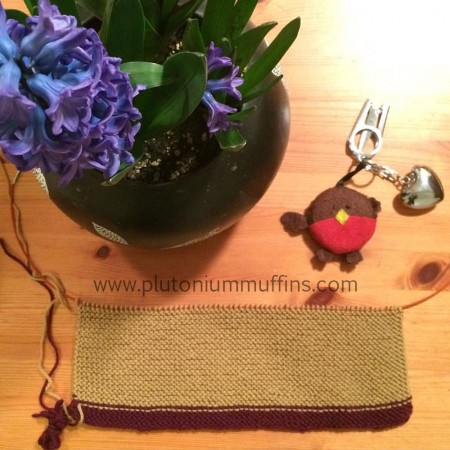
Here starts the repeated post about treating RSI, found here.
Dealing with RSI
The first thing to say is if you suddenly notice any of the symptoms, you must stop knitting immediately. Don’t even finish your row – I did, and by the end of the row I was in so much pain I was almost in tears. Even if the symptom is a just a throb, or a tiny bit of cramp that goes away, don’t take any chances; stop immediately.
Then, take a rest day. That’s right, a day where you don’t even pick your needles up. If it still hurts the next day, take another day. You want to keep resting until you have had at least a day symptom-free. This is hard, trust me, I know all about it. But, in the long run, it is for the better.
When you do go back to your knitting, don’t just go straight back into hours and hours of hard-core work. Let’s face it – you haven’t got RSI because you do a few minutes here and there; but to ensure a good recovery, you need to pretend that you are a person who can knit a row, then put it down and wander off to do something else.
So, while you are resting, what strategies can you employ to aid your recovery and ease discomfort? In general, this is actually inadvisable unless you are asleep – if you brace your wrist during the day, you cut down on the blood flow and activity in the muscles, which is essential for healing, and you can cause more damage than good. It does provide some immediate comfort though, so if the pain is really almost unbearable, I do recommend it. I had to wear it for two days (and this was all because I refused to stop in the middle of a VERY LONG row when my fingers started seizing up).
Sleeping with a brace can help, as it stops your wrist getting bent into funny positions while you sleep.
Icing the area also helps. The most drastic solution that I found on Ravelry came from Joshua Tucker. This is outlined below:
- Freeze several two litre bottles of ice.
- Fill kitchen sink with water and put frozen bottles in it.
- Over several hours, dip your pained arm in the ice-bath up to the elbow, for five to ten seconds.
- Do this at least ten times over the course of two hours.
- Do this for seven days at least.
Having spoken to my new osteopath friend, another recommendation was that you can buy a spray to keep the affected area cool. You can get these anywhere – UK readers will be able to find them in Boots – and they are fab for using at work. I will ‘fess up and say that I did not go straight out and buy one – but that has a lot to do with the state of my bank account, rather than my desire to heal myself!
My new osteopath friend also recommended yoga! I was doing yoga, but the aforementioned bank account has been stopping that. I will get back into it, I will. A large part of this is posture, and ensuring you have the best posture for your spine, muscles and circulation. Mine is terrible. I slouch, I hang my head off my shoulders, my back is never in the correct position…and I am trying to sort it out.
To sort it out, I have new lumbar support in my chair at work and everytime I think about my shoulders, I pull them back a bit. I need to pull my tummy in and just think about it a bit more. A few days of increased awareness has made some difference, I am pleased to report…
Lynda from the Kettle Yarn Co sent me this link, which has the below diagram from Interweave Crochet in it. A simple few stretches which make a huge difference. I don’t know why, but they just work.
The original post was published in February 2014, and checked by Dr OJ Ralley BSc MBChB for medical accuracy. If you have any further thoughts, please do share!
Much love,
Corrie xx
(Please forgive any repeated information within this post, it is two compiled blog posts about repetitive strain injury.)

I participate in many link parties; links to these can be found here.

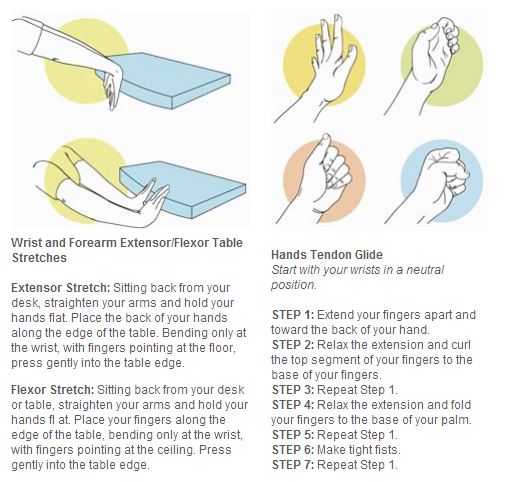
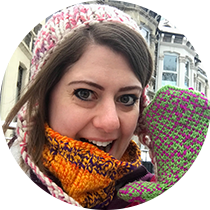






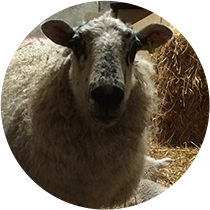
HI Corrie, Interesting post. Yes I’ve had RSI for knitting and crochet. The nattering helps when I have to stop and give my hands a break :O) Good to meet you yesterday.
Thanks for stopping by, lovely to see you! I think that scarf I’m working on has been making mine worse because the tension is so tight. Ah well! I’ll see you next time – won’t be this week as I’m up north and only get back on Thursday afternoon.
Great advice, Corrie. I am stopping by from yarn along… nice to meet you!
Thanks for this information, Corrie. You explained it very well. I’m going to try the ice cold water technique as I’ve got some pain in my arm and hopefully this will help
Hi Julia, have you tried the technique out? I hope it helped!